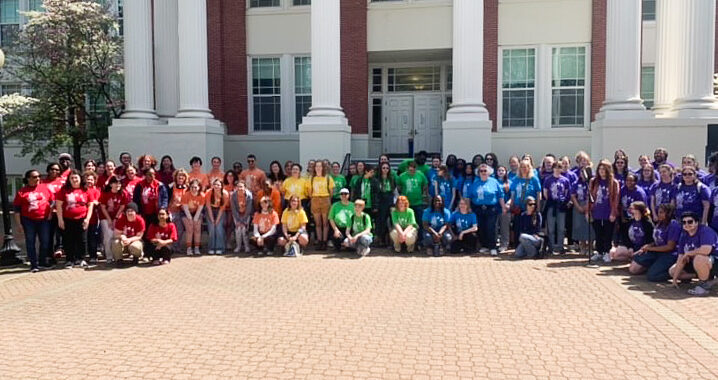Speaker advocates against pornography
5 min readBy MINDY MAULDIN
“In pornography men make hate to women’s bodies,” said anti-pornography activist Gail Dines to a responsive audience at the Great Hall on March 16.
Invited by the James Farmer Multicultural Center as the women’s history month committee’s Keynote Speaker, Dines, a professor at Wheelock College in Boston, spoke on the destructive effects of pornography on the psychology of a generation.
“[Pornography is] a serious public health issue,” said Dines. “[It’s] undermining equality and intimacy in relationships.”
Dines has been an anti-pornography advocate for over 20 years and founded the organization Stop Porn Culture in 2007. The group is “an educational and activist group made up of academics, anti-violence experts and community organizers concerned about the increasing pornification of the culture,” according to its website.
In her speech, Dines described the horrific human rights violations regularly enacted on women in the mainstream pornography industry.
She drew on her years of exhaustive research on pornography to demonstrate how pornography has revolutionized in the past decade to become altogether monstrous in its wide-scale real abuse of women on tape.
Many people have an outdated idea of what porn is like today and are unaware of the physical and verbal assault that is now the norm in mainstream pornography, according to Dines.
“This is not your father’s Playboy,” she said.
Mainstream pornography is no longer differentiated into soft core and hardcore, according to Dines. Instead, it is divided into “features” and “gonzo.”
Feature pornography has story lines and is less violent than gonzo productions. According to Dines, features are often used by boyfriends to groom their girlfriends into accepting the idea of porn-style sex.
“The real moneymaker is gonzo,” she said.
Gonzo is the most popular genre of porn today, according to Dines. She described it as being devoid of story lines and composed of “wall-to-wall” scenes involving “body-punishing sex” meant to harm, dominate and degrade the women involved.
“[A woman’s] average shelf life in the pornography industry is three months,” Dines said, citing an article in Adult Video News. “Their bodies can’t take it.”
Dines graphically described typical degrading acts videotaped in mainstream pornography and emphasized that such acts are the norm in today’s industry.
These typical acts depicted in porn include white heterosexual men vaginally, anally and orally penetrating women then doing the “money shot,” ejaculating onto women’s faces. Women are sometimes forced to consume the ejaculate, causing retching, according to Dines.
Often, multiple men penetrate a woman at a time in various orifices; and more than one man may penetrate an orifice at a time.
“The most popular act in pornography today is gagging,” said Dines.
She described an act in which a man forces his penis down a woman’s throat as far as possible, smothering her struggles for air and again causing retching.
Distended and battered at the orifices, exhausted and riddled with disease, women performing in pornography cannot take the abuse for a long period of time, according to Dines.
She cited the Adult Industry Medical Associates P.C., the voluntary health care for pornography performers, on some of the many conditions with which performers must cope, including gonorrhea of the eye from ejaculation on the face, chlamydia of the anus from anal penetration and anal prolapse, in which the anus drops out of the body.
Viewing such extreme levels of physical and verbal abuse distorts men’s views of sexuality, relationships, women and themselves, according to Dines.
“[It] changes what [men] want in sex,” she said. How dare the pornographers tell men what they want.”
Most men have been psychologically affected by pornography, Dines warned the audience.
“You have to assume that, and you have to deal with that in your dating,” she said.
Dines also described how ideas and fashions from pornography have infiltrated the culture.
“Most women have full bikini waxes because that is what their boyfriends have been masturbating to. Everyone has completely removed all of her pubic hair,” she said. “This is straight out of the [pornography] industry.”
According to Dines, people from 18 to 35 years old today “suffer from image overload.” Inundated by images, this generation’s communication is no longer “print-based” but “image-based.”
“My generation couldn’t say yes to sex. Your generation can’t say no,” said Dines.
Overwhelmed with hypersexualized imagery in pop culture and pornography, men and women are groomed into what feminist writer Pamela Paul calls “pornified” thought patterns.
Dines argued that the “pornification” of our culture grooms men for violence and women for abuse. Pornography is devoid of intimacy, compassion and affection, and frames sex as an opportunity to dominate and humiliate another human being.
As compelling as Dines’ speech was, the question-and-answer session that followed the was equally as remarkable. Dialogue between the audience and speaker was spirited and heated, extending into Dines’ book-signing session that followed.
Her 2010 book, Pornland: How Porn has Hijacked Our Sexuality, details her views on how gonzo porn directly and indirectly damages the lives of men and women.
The question-and-answer session reflected strong differences in generational values. Questions centered on types of pornography outside the gonzo category, such as LGBT and feminist pornography.
Students argued in favor of making these types of alternative pornography more available, saying they could redeem the industry.
If people started to watch pornography that was “not as evil,” as one commenter said, the societal role of pornography could be “reclaimed.”
Dines asked the audience why arguments about pornography center on genderqueer material and argued that alternative genres of pornography have not been effective in reclaiming pornography because most people still prefer gonzo films.
“[Reclamation] is not happening,” Dines said. “[Alternative pornography] is not the least bit effective.”
Although some students mentioned feminist pornography, Dines denied having ever succeeded in finding “feminist” pornography that did not contain the same flaws as gonzo porn.
Dines expressed frustration at the focus on producing alternative pornography instead of on focusing on political issues.
“We’ve lost our way,” Dines said. “What we’re witnessing is the death of feminism.”











